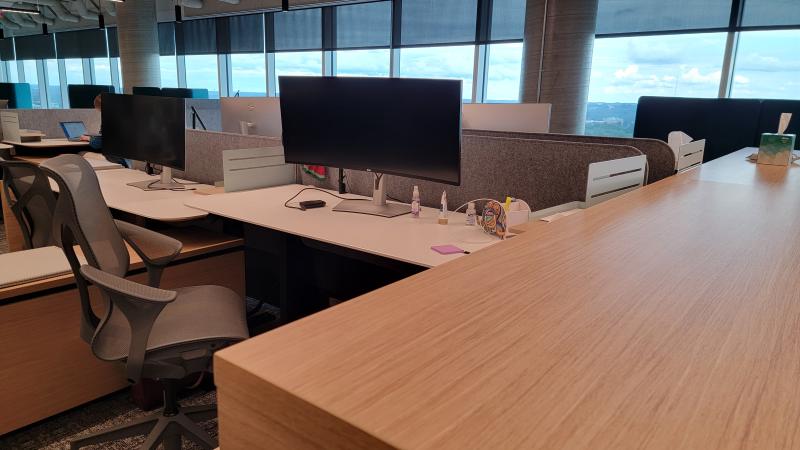Ahead of Marriott International’s official opening of its new headquarters in Bethesda, Md., next month, the company invited Hotel Management for a sneak peek. Here is the second of several articles on how the new space reflects not only Marriott’s new directions, but the shape of corporate hospitality to come.
Marriott International began planning its ideal headquarters six years ago, but the final product feels tailor-made to post-pandemic work expectations. The 21-story building, constructed from the ground up on the site of a former motel and parking lot at an estimated cost of $600 million, has amenities like a fitness room, treadmill desks, childcare facilities and flexible desk options across its 785,000 square feet.
“Everything in the building was designed to encourage our associates to come into the office to collaborate with each other; to bring partners, customers and owners into the building,” CEO Tony Capuano said. The project broke ground on June 21, 2018—well before the COVID-19 pandemic began, but Capuano said the team had to make relatively few changes as situations evolved. “I think the only thing we really did of note was [to] take some number of fixed workstations and repurpose those to have even more collaboration spaces than we had originally planned.”
As the business shifts “and gets more complex,” Capuano said, more of Marriott’s corporate work will involve multidisciplinary teams working on projects—“whether that's an hour project, a day project or a year project. We wanted to make sure we had enough spaces to accommodate that type of work.”
The flexibility is crucial to easing the challenges of the Great Resignation. In the early days of COVID, the company “eliminated a significant percentage of [its] workforce,” and is now looking to build that workforce back up. “We think this building and this work environment will be a significant competitive advantage,” Capuano said. “I think the childcare facilities, I think the fitness, I think the wellness elements, I think the cafeteria, I think proximity to public transport, I think the ability to walk to 50 different restaurants—I think all of it contributes to exactly what we think that next-generation workforce is looking for.”

Like many other franchisors, the company also is looking to boost employment numbers at its hotels. Before the pandemic, Marriott had approximately 6,000 vacant positions in its U.S. hotels, Capuano said, and those vacancies were spread across the country. More recently, he added, the numbers were closer to 8,100 or 8,200, and these are more concentrated in the markets that have recovered most quickly. “The good news is our applicant flow is up about 40 or 50 percent from where it was a year ago,” he added, and many of these applicants are new to the industry..
Shifting Demand
The corporation’s changing needs for its headquarters reflect the changing needs of its overall business. During the company’s Q2 earnings call, Capuano noted that group revenue per available room had “the most meaningful acceleration” in the quarter, down 1 percent to 2019 in June, compared to down nearly 30 percent in the first quarter.
At The Exchange in late July, Marriott brought several hundred corporate and association meeting planners together to discuss how the organizers and the hotel company could work together to drive bookings for meetings and events. At the event, Capuano said nearly all planners told him they planned to go into budget season with a volume of group meetings that was at or above where they were in 2019. Beyond that, he said many of the big consulting firms plan to hire tens of thousands of new professionals this year—and those new hires likely would be trained in person. “It is virtually impossible to immerse them in our culture through Zoom or [Microsoft] Teams,” Capuano recalled planners telling him. Many of those training sessions may well take place in hotels. “So we see the volume of training bookings growing exponentially,” he said.
Development and Operations
During the second quarter of 2022, Marriott signed more deals for new hotels than in any Q2 in the company’s history. While the company is not yet back to the mid-single-digit net unit growth percentage that it reported before the pandemic, Capuano thinks Marriott is “well on [its] way to getting back, and the development environment just continues to get better.”
The growth of bleisure travel is not only affecting how Marriott develops and designs its rooms, but what kind of brands the company is looking to grow, with “big-box group hotels” leading the way. The company recently broke ground on a new Gaylord hotel in Chula Vista, Calif.— “a $1.3 billion, 1,600-room big-box hotel which we think will be great,” Capuano said. “Even before the pandemic we saw leisure demand growing more rapidly than business demand. So we were already well on our way, from a growth perspective, to trying to rapidly accelerate our growth in resort destinations. I think our entry into all-inclusive has been a real accelerant to our growth in leisure.”
The growth of bleisure travel also is driving Marriott to challenge its owners and operators in different ways. If they cannot necessarily change the physical attributes of a property, they can look at its programming—“what they're doing with fitness and spa, what they're doing with their menus and their operating hours in food and beverage,” according to Capuano. On Wednesdays and Thursdays, he noted, guests might be wearing suits, but by Friday they’ll be wearing shorts and flip flops. “So they've got to think about how [they] program and pivot to provide the same level of service to you when you're there as a business traveler, and then, as you ease into a couple days of leisure, are we doing everything we can from a service perspective to accommodate that?”

